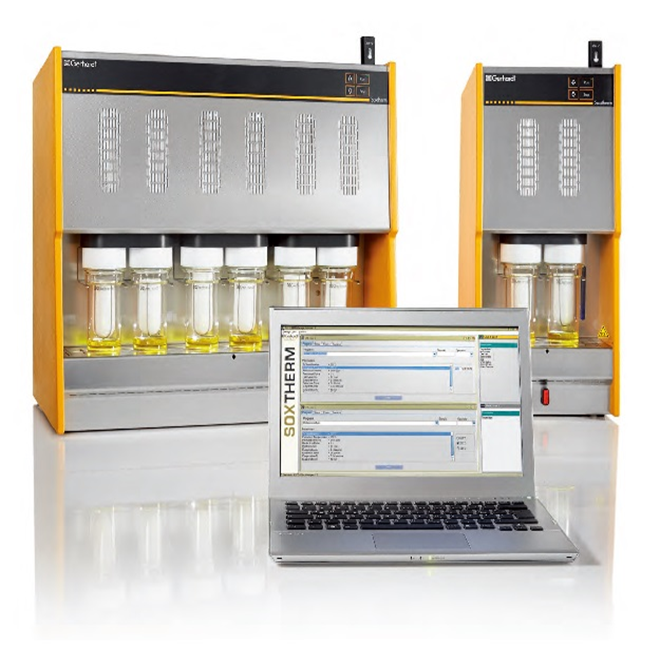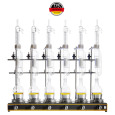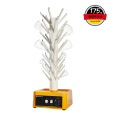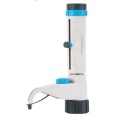方案详情
文
儿童玩具由人造材料制成,通常由邻苯二甲酸盐软化。这些合成化合物作为增塑剂添加到PVC中,以提高其弹性和灵活性。邻苯二甲酸盐会危及暴露于其影响的儿童的健康。使用格哈特 SOXTHERM索克森全自动快速索氏萃取,GC-MS测定克罗地亚儿童玩具和儿童保育用品中的邻苯二甲酸酯。
方案详情

儿童玩具由人造材料制成,通常由邻苯二甲酸盐软化。这些合成化合物作为增塑剂添加到PVC中,以提高其弹性和灵活性。邻苯二甲酸盐会危及暴露于其影响的儿童的健康。使用格哈特 SOXTHERM索克森全自动快速索氏萃取,GC-MS测定克罗地亚儿童玩具和儿童保育用品中的邻苯二甲酸酯。克罗地亚儿童玩具和儿童保育用品中的邻苯二甲酸酯RESEARCH COMMUNICATIONS RESEARCH COMMUNICATIONS Phthalate in children’s toys and childcare articles in Croatia Lidija Barušić1, Antonija Galić1, Jasna Bošnir1, Lidija Baričević1, Ivana Mandić-Andačić1, Adela Krivohlavek1, Ana Mojsović Ćuić2 and Domagoj Đikić3,* 1Institute of Public Health, Dr Andrija Štampar, Department of Ecology, Zagreb, Croatia 2University of Applied Health Studies, Department of Environmental Health Engineering, Zagreb, Croatia 3University of Zagreb, Faculty of Science, Department of Animal Physiology, Zagreb, Croatia Children’s toys are made of artificial material often softened by phthalates. These are synthetic compounds added to PVC as plasticizers for the purpose of im-provingitselasticityandflexibility.Phthalatescan endanger the health of children exposed to their effect by inducing reproductive, hormonal and developmen-tal disorders. The goal of the present study was to de-terminephthalatepresenceinchildren’stoysand childcare articles from different sources sold in differ-entareasinCroatiain2012and2013.Diisononyl phthalate, di(2-ethylhexyl) phthalate(DEHP), dibutyl phthalate,diisodecylphthalate,di-n-octylphthalate and butylbenzyl phthalate were included in the analy-sis. About 60% of the toys analysed contained plastic; up to 20% had detectible levels of phthalates, 94–96%containing toxic DEHP. Over 60% contained DEHP at concentrations more than 10 times than that permitted, mostly dolls and toy animals. The percentage of toys containing phthalates was higher in 2013 in compari-son to 2012. We discuss the availability and similari-ties in composition of phthalates by comparing our results with reports from other countries. Keywords: Childcare articles, children’s toys, chroma-tography, phthalates. CHILDREN’S toys are one of the most important and high-ly controlled products of common use in the European Union(EU).Toysinthemarketplaceshouldbein compliance with the applicable legislation in the EU for the protection of consumer health and safety, as well as the environment1. However, the strict requirements do not prevent the manufacture and sale of toys which do not meet the set standards. Children’s toys are defined asproductsthatare designed or intended for use by children up to 14 years of age.Childcare articles are products intendedforsleep facilitation, relaxation, hygiene, feeding or sucking by the children1. Toys and childcare articles made of polyvinyl chloride(PVC) usually contain softeners or plasticizers which enable flexibility. Plasticizers that are mostly used for the improvement of elasticity in PVC are phthalates(Figure 1) or diesters of ortho-phthalic acid(di-alkyl or alkyl aryl esters 1,2-benzenedicarboxylic acid)2–5. At a global level, 6 million tonnes of softeners are used per year, including 1 million used in Europe, 80% of which includes phthalates6. Phthalates are a serious threat to the environment and human health6. They do not form cova-lent bonds and thus easily migrate when in contact with lipophilicmatter6,7.Afterphthalateintake,monoesters and oxidative metabolites are formed during biotransfor-mation8.Forexample,afteringestionofDEHP,30metabolitesareformed,namelymono-(2-ethyl-5-hexyl) phthalate(MEHP),mono-(2-ethyl-5-oxohexyl) phthalate(MEOHP), mono-(2-ethyl-5-hydroxyhexyl) phthalate(MEHHP) and mono-(2-ethyl-5-carboxypentyl) phthalate(MECPP). MEHP is primarily formed by DEHP hydroly-sis in the gastrointestinal tract, which is then absorbed, while MEOHP, MEHHP and MECPP are formed by liver oxidative metabolism of MEHP and are present in con-centrations3–5timesgreaterthanMEHPinurine9,10. Humanexposuretophthalatesoccursthroughfood, mother’s milk, by inhaling, chewing plastic and through skin contact11. Toys and childcare articles that can be placed in the mouth, even if not intended for that pur-pose, present a health risk for children if they contain phthalates12,13. Determination of the allowed legislative levelsisbasedonriskestimationandexposuredose extrapolations; it is not a simple process. The guidelines for allowed estimated dose exposure to individual phtha-late types are explained in detail by CSTEE(European Scientific Committee on Toxicity, Ecotoxicity and Environment)2.ByCommissionRegulation(EU)No.143/2011, the EU has categorized phthalates as reproduc-tivetoxiccompoundsofcategory1Bandregulated the maximal allowed amounts of these toxic chemicals in toys and childcare article12,14,15. Toxicological reports show a connection between phthalates and breast cancer16. Phthalates might potentiate their adverse effects combined with other chemicals17. They are res-ponsible for changes in brain function during the devel-opment of boys by influencing testosterone levels and contribute to obesity in children18,19. High exposure to phthalatesisalsoassociatedwiththeuseofmedical productscontainingDEHPorDBP20.Animaltoxicity Figure 1. General structure of phthalates, R and R are the same or different alkyl or aryl groups. CURRENT SCIENCE, VOL. 109, NO. 8, 25 OCTOBER 2015 Table 1. Samples of toys and childcare articles sold in Republic of Croatia collected for analysis of phthalate content Toys Articles(bottles etc.) Sample Total N of samples N Toys Analysed for phthalate content N Articles Analysed for phthalate content* All sampled child articles 555 518 255 37 37 2012 336 301 98 35 35 2013 219 217 157 2 2 *In childcare articles, phthalate was below detection limit. Table 2. Products containing plastic shown by product type in joint analysis of all samples(total) and separate analysis by year of import(2012 and 2013) Products containing phthalates above detection limit(% of N per product type) Toys Total N N 2012 N 2013 % of Total N % of N 2012 % of N 2013 Dolls 94 39 55 24 28 22 Animals 68 21 47 9 14 6 Balls 18 12 6 22 17 33 Cars 26 8 18 0 0 0 Tools, shovels buckets 21 8 13 0 0 0 Arms 9 6 3 0 0 0 Make-up set 3 1 2 0 0 0 Others 16 3 13 0 0 0 Articles Soothers 22 20 2 0 0 0 Bottles 5 5 0 0 0 0 Chewing soothers 10 10 0 0 0 0 Total N samples analysed 292 133 159 studies indicate that DEHP causes hepatotoxicity through peroxisome proliferation, DINP causes appearance of liver neoplasms, while DEHP and BBP modify rat breeding, causing pronounced testicular and sperm damage; such adverse endocrine effects were observed even in offspring of exposed pregnant females2,21–24. Studies showed that DEHP is one of the most toxic phthalates with accidental poisoning recording lethal DEHP concentrations 0.3 to1.0 mg/kg(ref. 4). Attempts have been made to regulate and replace DEHP by DINP7. However, the margins of safety are lower for DINP and DEHP than for DNOP, DIDP, DBP and BBP2. Thus, exposure to DINP is also a cause for concern. There is also a synergistic interaction between more phthalate types that can be present in chil-dren’s toys and multiple sources of child exposure2. Thus monitoring the levels of various phthalates and the analy-sis of their source is important. The present study is an analysis of phthalates in child products during a period of the adaptation of the legislative framework for phthalate control prior to the accession of the Republic of Croatia to the EU. The earlier legislation was significantly differ-ent regarding the values of prohibited and/or restricted allowable phthalate concentrations and did not prescribe limits for certain phthalates. We show that the status of phthalate levels was not satisfactory, although prior to the entryofCroatiatotheEU,thehigherEUstandards started to be applied. In particular, the study shows that despite the introduction of controls, there was an increase in the number of toys softened by prohibited phthalates recorded between two consecutive years. By analysis of particulartypesofphthalateswewantedtofindout whether those like DEHP whose adverse effects are well known, could still appear in the even with strict laws of the EU. Samples of toys and childcare articles(N= 555) were collected from the markets in the Republic of Croatia in the years 2012 and 2013. Table 1 shows the number of samples collected in 2012 and 2013, and the number of analysed samples. Samples that contained plastic materi-als were chosen for phthalate analysis. Tables 2 and 3give the product type and country of origin. Analysis in-cludedDEHP,CASNo.117-81-7/ECNo.204-211-0; DBP, CAS No. 84-74-2/EC No. 201-557-4; BBP, CAS No. 85-68-7/EC No. 201-622-7; DINP, CAS No. 28553-12-0,68515-48-0/ECNo.249-079-5and271-090-9; DIDP,CASNo.26761-40-0and68515-49-1/ECNo.247-977-1 and 271-091-4, and DNOP, CAS No. 117-84-0/EC No 204-214-7. Phthalates in toys and childcare articleswere deter-mined by GC-MS, operated in selected ion monitoring (SIM). GC-MS was chosen because it is highly specific and widely available, whereas SIM provides higher sensi-tivity. The most abundant ion formed in the mass spec-trometer is called the base peak. In the mass spectra of phthalates(Figure 2), the base peak is indicated at the m/z value of 149. Identification and quantification of phtha-latesusedtheextractedionm/z149,foreachofthe phthalates tested, except for DNOP and DINP, because of co-elution of both. For DNOP, m/z value of 279 was used for quantification, while for DINP m/z it was 293. Con-firmation of presence was monitored by the following qualifier ions: m/z 149(DNOP), m/z 223(DBP), m/z 149(DINP), m/z 307(DIDP), and m/z 206(BBP). Method for determination of phthalates in toys and childcare articles is based on extraction of sample with dichloromethane on Soxtherm, followed by GC-MS analysis of the resulting extracts. Determination of phthalates was performed on ShimadzuGC-MSQP2010,usingelectronionization(EI) mode. Separation was performed with a SPB-5(5%diphenyl, 95% dimethyl siloxane) capillary GC column,60 m, 30 mm ID, with film thickness of 0.25 m. The column was held at 40C for 5 min, ramped at 10C/min to 280C and finally held for 21 min. The gas chromato-graph was operated in split/splitless injection mode at a temperature of 280C.The method has beenvalidated according to the HRN EN 14372: 2004 norm, with some modifications regarding extraction time and quantity of analysed sample. Satisfied recovery was achieved with extraction time of 4 h instead of 6 h, and with 1 g of sam-pletaken intotheprocedureinstead of2 g. This improvement, shorter extraction time and smaller sample amountleadtobetterefficacy,provenbyproficiency testing25,26. In order to construct a calibration curve, re-gression of peak area on concentration was undertaken using the external standard calibration method. The assay linearity was studied by injection of five different stan-dard concentrations in the range 0.5–15 g ml–1 for DBP, BBP, DEHP and DNOP, and 1.0–20 g ml–1 for DINP andDIDP.Allcorrelationcoefficientswere> 0.990. Limitofdetection(LOD)andlimitofquantification(LOQ) were established by analysing samples with added analytes in different concentrations considering signal-to-noise(S/N) ratio 1: 3 for LOD and 1: 10 for LOQ. LOD Table 3. Country of origin of analysed products Country of origin Total N Products containing phthalates above detection limit(N) China 272 47 Germany 14 0 UK 1 0 Italy 2 0 France 1 0 USA 1 0 Macedonia 1 1 was0.005%forDBP,BBP,DEHPandDNOP,and0.01% for DINP and DIDP, while LOQ was 0.01% and0.02% respectively. Recovery was determined by analys-ing samples spiked at five different concentration levels. Each level has been prepared and analysed in duplicate. Recovery range was from 90% for DINP to 98% for BBP. Measurement precision was examined by injecting seven replicateinjectionsofstandard(RSD< 5%).Method precision was examined by analysing spiked sample in triplicate(RSD< 10%). In statistical analysis, the descriptive statistics is shown bypercentageratiosand differencesin percentage between the different years of sampling were tested with chi-square test(2) with the level of significant difference of P 0.05 between the years. Concentrations of individ-ual types of phthalates from the total analysed sample are shown in mean values and by standard deviation, but be-cause of the large range of data, median value is shown together with minimal and maximal values. Concentra-tion range is shown graphically as a distribution of per-centage ratio for individual percentage concentration of DEHP. A correlation between percentage concentration of DEHP and other phthalates was made. However, as no statistically significant correlation was found, the analy-sis is not shown. From the total of 555 collected samples intended for use among children, around 60% contained plastic mate-rials(Figure 3 a). Also 40% of the samples collected in2012 and 80% of the samples collected in 2013 contained plastic materials(Figure 3 a; 2, P 0.05). The products that contained plastic were chosen for phthalate analysis(Table 1). Figure 3 b shows that 16% of all samples con-tained detectable levels of phthalate. When analysing the products that contained phthalates per year, 20% of the samples collected in 2013 and only 12% of the samples collected in 2012 contained phthalates. Although in 2013the phthalate percentage was indicatively higher, statisti-cal analysis(2) showed that there was no significant dif-ferencebetweentheyears.Alloftheproductsthat contained phthalatesweretoys.Noneofthechildcare articlescontained phthalates(Table2).From the total analysed toys(N= 255), dolls were the most abundant type(36%ofanalysedsamples),followedbyanimals(26%), cars(10%) and tools(8%), whereas other types were present to a lesser extent(Table 2). Phthalates were found in 24% of dolls, 22% of balls and 9% of cars and they were not found in other types of toys(Table 2). Most of the analysed products(93.4%) were manufactured in China; therefore,mostofthe productswith detectible levels of phthalates were from China(Table 3). Figure 3 c shows the percentage distribution of individual phthalate type amongst the positive samples. Forbidden DEHP was present in 95.8% of positive samples, DINP was present in 41.7% of positive samples and DBP was present in16.7% of positive samples. DIDP and DNOP were found in only one sample(thus the n.a. mark in Table 4 for min, Figure 2. (Top) Chromatogram of GC-MS(sample inoculated by external standard), of six phthalate types ana-lysed; retention time given in parenthesis.(Bottom), Sample without phthalates. Percentage of different phtalate types within positive samples *Percentage of plastic toys was significantly different between two years, x(Ps0.05) Figure 3. a, Percentage of plastic toys and articles in joint analysis of all samples(total) and separate analysis by year of import(2012 and 2013). b, Percentage of products positive for phthalate content above detection limit in the joint analysis of all samples(total) and separate analysis by year of import(2012 and 2013). c, Individual phthalate type distri-bution(%) of positive child products of all samples(total) and separate analysis by year of import(2012 and 2013). Figure 4. a, Percentageof products containg different DEHP concentrations(0–40%(w/w)).b,Thepercentage(%)ofproducts containg different DEHP concentrations(0–40%(w/w)) analysed sepa-rately by year of import(2012 and 2013). max and SD), and none of the samples contained BBP. Figure4showsproducts(expressedaspercentageof phthalate positive products) containing DEHP expressed as concentration percentage weight(w/w) range(0–1%,1–10%, 10–20%, 20–30% and 30–45%). Results show that over 60% of the positive samples contained more than 10%(w/w) of DEHP. Among the products collected in 2012 none contained over 30%(w/w) of DEHP, while among products collected in 2013, 19% contained high concentrations of DEHP(between 30 and 45%(w/w)). Correlation analysis did not show any statistically signifi-cant connection; thus it is not presented here. The results of the present study show that phthalates were, present to a great extent, in the market, at the time when the Croatian legislative and control was adopting and introducing the legislative of the EU. The EU limited the use of DEHP, DBP and BBP in children’s toys and childcare articles to a maximum percentage concentration of 0.1%(w/w) and restricted the use of DINP, DIDP and DNOP in toys and childcare articles which can be placed in the mouth. It was expected that the importers and ven-dors in Croatia would reduce the presence of toys con-taining thephthalatesduetothestrict EU regulation. However the results reveal the opposite. Out of 60% of the toys in the market that contain plastic, approximately12–20% had detectible levels of phthalate. In similar EU studies, conducted in Germany, Austria and Switzerland, higher presence of phthalates(27%) in the analysed samples has been reported, with 8% being articles for children27. However, in the case of childcare articles designed for chewing(bottles, baby soother, etc.) for children under 3 years of age, phthalate was not re-corded in our study. We found that among positive sam-ples majority contained DEHP(96%; Figure 3 c). Over60%containedDEHPinconcentrations morethan10times greater than that permitted(Figure 4); mostly dolls and toy animals, with an average value more than 100times greater than the allowed percentage concentration of 0.1%(w/w). Similar results were obtained in a study conducted in India, which also reported DEHP in 96% of products made in China, Taiwan, Thailand and India28,29. ThemaximaldetectedDEHPconcentrationwas45%(w/w),whichis450timesgreaterthanthatallowed(Table 4). Since DEHP synthesis in 1993, toxicological studies have shown its toxic effects on the liver, induc-tion of testicular atrophy30,31, on androgynous signalling pathway32, premature mammary growth in females33; and it has also been added to a list of carcinogens according toAnnexIoftheCouncilDirective67/548(refs34,35). The second most commonly detected phthalate above the highest permissible value was DINP found in 41.7%of the samples with concentration ranging from 0.02% to40%(w/w)(Figure 3 c and Table 4). The second most common phthalate in toys and childcare articles in the Indian market was also DINP(42% of the samples)28, ranging from 0.1% to 16.2%(w/w). Even though Indian and Croatian studies detected DINP as the second most abundant phthalatetype, other studieshaveshown showed DINP as the most abundant in child products, fol-lowed by DEHP, DIOP and DIDP2,27–29. Samples of dolls fromastudyconductedbyBiedermann-Bremetal.27showed thatDINCH(diisononyl-cyclohexane-1,2-dicar-boxylate) was the most abundant phthalate in dolls and articles for children. In the present study(Figure 3 c and Table 4),thethird mostcommon phthalatewasDBP, followed by DIDP and DNOP, with 2% of positive sam-ples,maximalconcentrationbeing0.53%(w/w)and0.08%(w/w) respectively. None of the samples contained BBP. DBP, DNOP and BBP were detected in relatively low concentrations, while DBP and BBP were present in less than 1% of the samples. Therefore it is considered that they are by-products of technological procedure and notintentionallyadded2,27–29.Theliteraturerevealed thatChinamanufacturedthelargestnumberofsuch toys2,27–29,35. From the present study we have gained important data for risk assessment of exposure of children to phthalates from toys in 2012 and 2013, prior to the introduction of legislative of the EU. Based on these data it could be estimated that there is a high possibility that among 20toys bought in 2012 and 2013, especially plastic dolls, fourcouldcontainDEHPwhile 2–3wouldhave high probability of containing DEHP in concentrations 100–400timesgreater thanthatallowed.Thus,wecannot CURRENT SCIENCE, VOL. 109, NO. 8, 25 OCTOBER 2015 Table 4. Detected phthalates and their concentration expressed as per cent weight unit(w/w%) found in the analysed products Min Max Median Average Phtalate type CAS no. LOD%(w/w) (w/w%) (w/w%) (w/w%) (w/w%) SD Bis(2-ethylhexyl) phthalate 117-81-7 0.005 Total sample 2012 2013 0.311.15 0.31 45.00 26.00 45.00 13.00 12.00 17.00 15.99 11.89 17.59 11.48 7.50 12.90 Dibutyl phthalate 84-74-2 0.005 Total sample 2012 0.02 0.02 5.30 0.26 0.23 0.01 0.86 0.04 1.60 0.07 2013 0.23 5.30 0.60 1.76 2.06 Benzyl butyl phthalate 85-68-7 0.005 Total sample n.d. n.d. n.d. n.d. n.d. 2012 n.d. n.d. n.d. n.d. n.d. 2013 n.d. n.d. n.d. n.d. n.d. Di-‘isononyl’ phthalate 68515-48-0 0.01 Total sample 0.02 40.00 0.60 0.00 8.97 2012 0.02 40.00 0.01 4.16 10.79 2013 0.19 2.41 0.60 0.76 0.63 Di-n-octyl phthalate 117-84-0 0.005 Total sample 0.08 0.08 n.a. n.a. n.a. 2012 0.08 0.53 n.a. n.a. n.a. 2013 n.d. n.d. n.d. n.d. n.d. Di-‘isodecyl’ phthalate 26761-40-0 0.01 Total sample 0.53 0.53 n.a. n.a. n.a. 2012 n.d. n.d. n.d. n.d. n.d. 2013 0.53 0.53 0.53 n.a. n.a. LOD, Limit of detection= 0.1%; n.d., Not detected(less than LOD); n.a., Not applicable. totally disregard or neglect the risk of exposure, espe-cially considering that some toys are used for a number of consecutive years by children. On the basis of this infor-mation further studies on exposure are needed. Neverthe-less, the percentage of 12–20% of products containing phthalates was expected to be lower since their maximal residue levels were regulated by law and restricted be-cause of their toxicity. We conclude that phthalates are still being used in the manufacture of toys and other articles endangering the health of children. Considering the fact that the global toy market is worth US$ 105 billon28, it is clear that the issue exceeds health standards of individual countries. Hence, studiesontheharmfuleffectsofphthalatesandtheir presence in objects of common use, as well as exposure to phthalates of risk groups should be done in all coun-tries with and legislative control the countries of manu-facture in order to minimize this global health problem, especially considering the health of children. 1.Directive2009/48/ECoftheEuropeanParliamentandofthe Council,Safetyoftoys.Off.J.Eur.Union,2009, 48,L170; http://eurlex.europa.eu/LexUriServ/LexUriServ.do?uri=OJ:L:2009:170:0001:0037:en:PDF 2.European Scientific Committee for Toxicity, Ecotoxicity and the Environment(CSTEE). Phthalate migration from soft PVC toys and child-care articles. In CSTEE Third Plenary Meeting, Brus-sels,1998;http://ec.europa.eu/health/scientifi_committees/environ-mental_risks/opinions/sctee/sct_out19_en.htm 3.Heudorf, U., Mersch-Sundermann, V. and Angerer, J., Phthalates:toxicology and exposure. Int. J. Hyg. Environ. Health, 2007, 210,623–634. CURRENT SCIENCE, VOL. 109, NO. 8, 25 OCTOBER 2015 4.Jurica, K., Ursulin-Trstenjak, N., Vukic-Lusic, D., Lusic, D. and Smit, Z., Phthalates in alcoholic beverages. Arh. High. Rada Tok-sikol., 2013, 64, 317–325. 5.Shengming, W. et al., Analysis of four phthalate monoesters in humanurineusingliquidchromatography-tandemmassspec-trometry. LC/GC North America, 2014, pp. 434–439. 6.Scott, A., Industry calls for an end to EU phthalates ban. Chem. Week, 2003, 159, 21. 7.Serrano, S. E., Braun, J., Trasande, L., Dills, R. and Sathyanara-yana, S., Phthalates and diet: a review of the food monitoring and epidemiology data. Environ. Health, 2014, 13(1), 43. 8.Latini, G., Monitoring phthalate exposure in humans. Clin. Chim. Acta, 2005, 361, 20–29. 9.Barr, D. B. et al. Assessing human exposure to phthalates using monoesters and their oxidized metabolites as biomarkers. Environ. Health Perspect., 2003, 111, 1148–1151. 10.Koch, H. M., Rossbach, B., Drexler, H. and Angerer, J., Internal exposureofthegeneralpopulationtoDEHPandotherphtha-lates – determination ofsecondary and primary phthalate mono-ester metabolites in urine. Environ. Res., 2003, 93, 177-185. 11.National Biomonitoring Program, Phthalates overview. Centers for DiseaseControlandPrevention,CDC24/7,2014;http://www. cdc.gov/biomonitoring/DEHP_BiomonitoringSummary.html 12.Directive2005/84/ECoftheEuropeanParliamentandofthe Council, Amending for the 22nd time Council Directive76/769/EEContheapproximationofthelaws,regulationsand administrative provisions of the Member States relating to restric-tions on the marketing and use of certain dangerous substances and preparations(phthalates in toys and childcare articles). Off. J. Eur. Union, 2005, 84, L344; http://eurlex.europa.eu/legalcontent/EN/TXT/HTML/?uri=CELEX:32005L0084&from=EN 13.Sathyanarayana, S., Karr, C. J., Lozano, P., Brown, E., Calafat, A. M., Liu, F. and Swan, S. H., Baby care products: possible sources of infant phthalate exposure. Pediatrics, 2008, 121, e260–e268. 14.Regulation(EC) No. 1907/2006 of the European Parliament and of the Council, Concerning the Registration, Evaluation, Authorisation and Restriction of Chemicals(REACH). Off. J. Eur. Union, 2006,1907, L396; http://ec.europa.eu/environment/chemicals/reach/legislation_en.htm 15.De Coster, S. and Van Larebeke, N., Endocrine-disrupting chemi-cals: associated disorders and mechanisms of action. J. Environ. Publ. Health, 2012, 52. 16.López-Carrillo, L. I. et al., Exposure to phthalate and breast can-cer risk in northern Mexico. Environ. Health Perspect., 2010, 118,539–544. 17.Waring, R. H. and Harris, R. M., Endocrine disrupters – a threat to women´s health? Maturitas, 2011, 68, 111–115. 18.Swan,S.H.etal.,Prenatalphthalateexposureandreduced masculine play in boys. Int. J. Andral., 2009, 32, 1–9. 19.Teitelbaum, S. L. et al., Associations between phthalate metabo-lite urinary concentrations and body size measures in New York City children. Environ. Res., 2012, 112, 186–193. 20.Ursel,H.,Mersch-Sundermann,V.andAngerer,J.,Phthalates:toxicology and exposure. Int. J. Hyg. Environ. Health, 2007, 5,623–634. 21.EFSA, Opinion of the Scientific Panel on FoodAdditives, Fla-vourings,ProcessingAidsandMaterialsinContactwithFood(AFC)onarequestfromtheCommissionrelatedtobis(2-ethylhexyl)phthalate(DEHP)foruseinfoodcontactmaterials. EFSAJ.,2005,243,1–20;http://www.efsa.europa.eu/en/efsa-journal/doc/243.pdf 22.Arcadi, F. A., Costa, C., Imperatore, C., Marchese, A., Rapisarda, A. and Salemi,M., Oral toxicityof bis(2-ethylhexyl)phthalate during pregnancy and suckling in the Long-Evans rat. Food Chem. Toxicol., 1998, 36, 963–970. 23.Poon, R., Lecavalier, L., Mueller, R., Valli, V., Procter, B. and Chu, I., Subcronical oral toxicity of di-n-octyl phthalate and di(2-ethylhexyl) phthalate in the rat. Food Chem. Toxicol., 1997, 35,225–229. 24.Ward, J. M., Peters, J. M., Perella, C. M. and Gonzalez, F. J., Receptorandnonreaceptor-mediatedorgan-specifictoxicityof di(2-ethylhexyl) phthalate in peroxisome proliferator-activated re-ceptor-alpha-null mice. Toxicol. Patoph., 1998, 26, 240–246. 25.LGCproficiencytestingschemes,LGC-Standards,Instituteof Public Health, Individual Report, 2015; http://www.renar.ro/files/6714/2780/8169/LGC-PT-Brochure-2015_with_price.pdf 26.LGC, Testing schemes, TY0136-Institute of Public Health Individual Report, https://www.lgcpt.com/PTCatalogue/en-GB/PTCatalogue.pdf 27.Biedermann-Brem, S. et al., Plasticizers in PVC toys and child-care products: What succeeds the phthalates? Market survey 2007. Chromatography, 2008, 68(3-4), 227–234. 28.Johnson, S., Saikia, N. and Sahu, R., Phthalates in toys available in Indian market. Bull. Environ. Contam. Toxicol., 2011, 86, 621–626. 29.Stringer, R., Labunska, I., Santillo, D., Johnston, P., Siddorn, J. and Stephenson, A., Concentrations of phthalate esters and identi-fication of other additives in PVC children’s toys. Environ. Sci. Pollut. Res. Int., 2000, 7, 27–36. 30.Frederiksen, H., Skakkebek, N. E. and Andersson, A. M., Meta-bolism of phthalates in humans. Mol. Nutr. Food Res., 2007, 51,811–911. 31.Luo,H.,Sun,G.,Shi,Y.,Shen,Y.andXu,K.,Evaluation of the di(2-ethylhexyl) phthalate released from polyvinyl chloride medical devices that contact blood. Springer Plus, 2014,3, 58. 32.Bajkin, I., Bjelica, A., Ičin, T., Dobrić, V., Kovačev Zavišić, B. and Medić Stojanoska, M., Effects of phthalic acid esters on fetal health. Med. Pregl., 2014, 67, 172–175. 33.Colon, I., Caro, D., Bourdony, C. J., Bourdony, C. J. and Rosario, O., Identification of phthalate esters in the serum of young Puerto Rican girls with premature breast development. Environ. Health Perspect., 2000, 108, 895–900. 34.Marin, M. L., Lopez, J., Sanchez, A., Vilaplana, J. and Jimenez, A.,Analysisofpotentiallytoxicphthalateplasticizersusedin toysmanufacturing. Bull. Environ. Contam. Toxicol., 1998, 60,83–73. 35.EuropeanCommission, KeepingEuropeanConsumersSafe –Annual report on the operation of the Rapid Alert System for non-food dangerous products (RAPEX) 2012 and 2013. http://ec.europa.eu/dgs/health_consumer/index_en.htm(assessedon25June 2014) Received 15 January 2015; revised accepted 13 June 2015 doi: 10.18520/v109/i8/1480-1486 Biogeochemistry of shallow lake sediments: a case study from Verlorenvlei, South Africa Supriyo Kumar Das1,*, Joyanto Routh2 and Alakendra N. Roychoudhury3 1Department of Geology, Presidency University, 86/1 College Street, Kolkata 700 073, India 2Department of Water and Environmental Studies, Linköping University, 581 83 Linköping, Sweden 3Department of Earth Sciences, Stellenbosch University, Private Bag X1, Maiteland 7602, South Africa Studyingthebiogeochemistryofshallowlakesedi-ments, especially the source of sedimentary organic matter(OM), is challenging because of the low pres-ervation of OM in shallow lake sediments. Here we reportthesourceofsedimentary OMinashallow freshwater lake, Verlorenvlei, in South Africa using a number of biogeochemical proxies. Elemental carbon and nitrogen ratio(C/N), and stable C and N isotopes( 13C and 15N) indicate algal source of the sedimen-taryOM.TotalorganicandinorganicC,different phosphorus fractions, 13C and 15N values indicate repetitive presence of non-N-fixing cyanobacteria un-dermoderateN-limitedconditions.Cyanobacterial population in Verlorenvlei is likely influenced by the availability of dissolved inorganic C. Cyanobacterial proliferation in the lake has ceased with accelerated N input as recorded at the top of the core. Keywords: Carbon,cyanobacteria,nitrogen, organic phosphorus, shallow lakes, stable isotopes. PRIMARYproductionisamajorbioticprocessinthe lakes. In-lake primary production responds quickly under stresses induced by anthropogenic activities such as ex-ternalnutrients(nitrogenandphosphorus)inputfrom *For correspondence.(e-mail: sdas.geol@presiuniv.ac.in)
确定
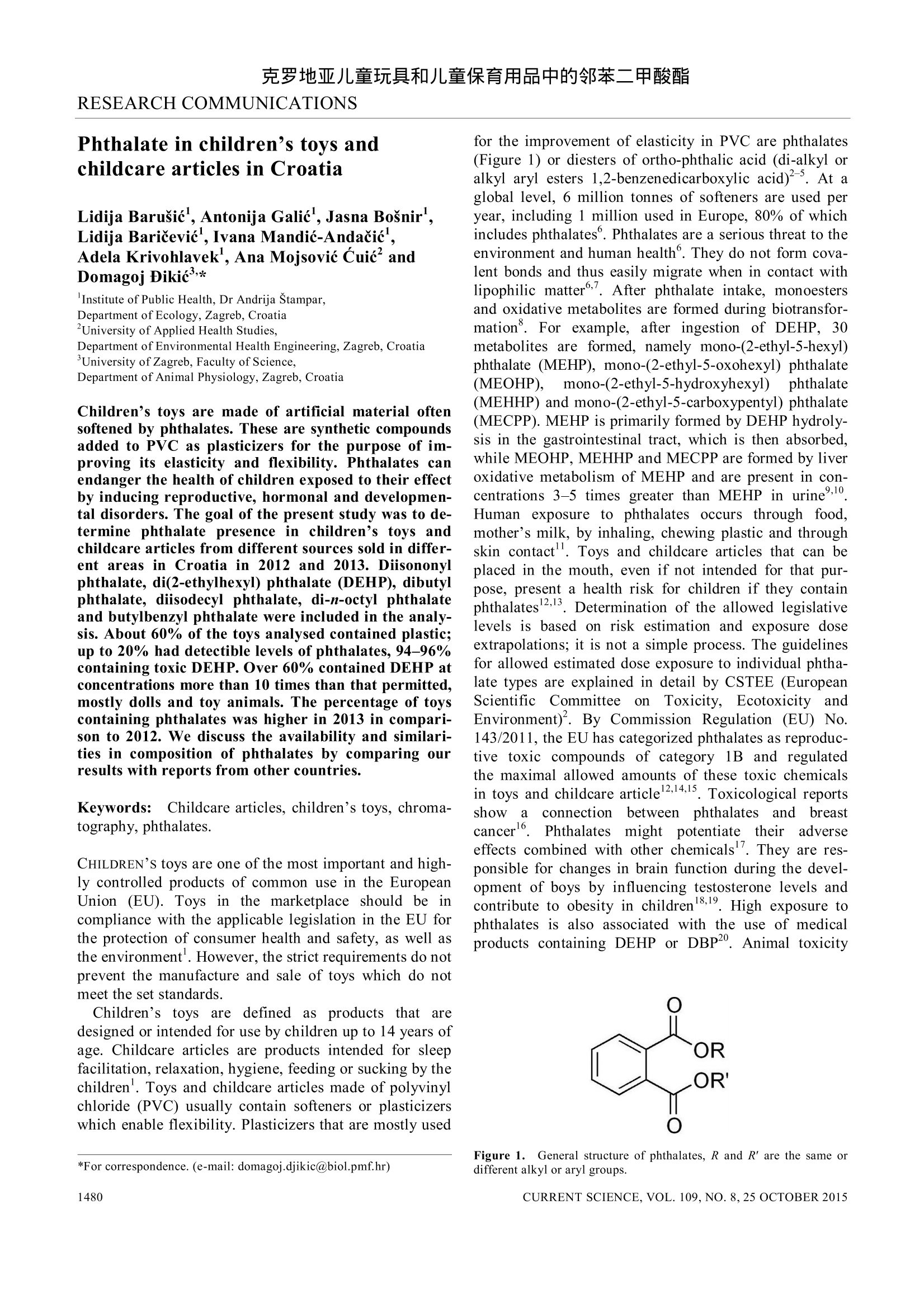
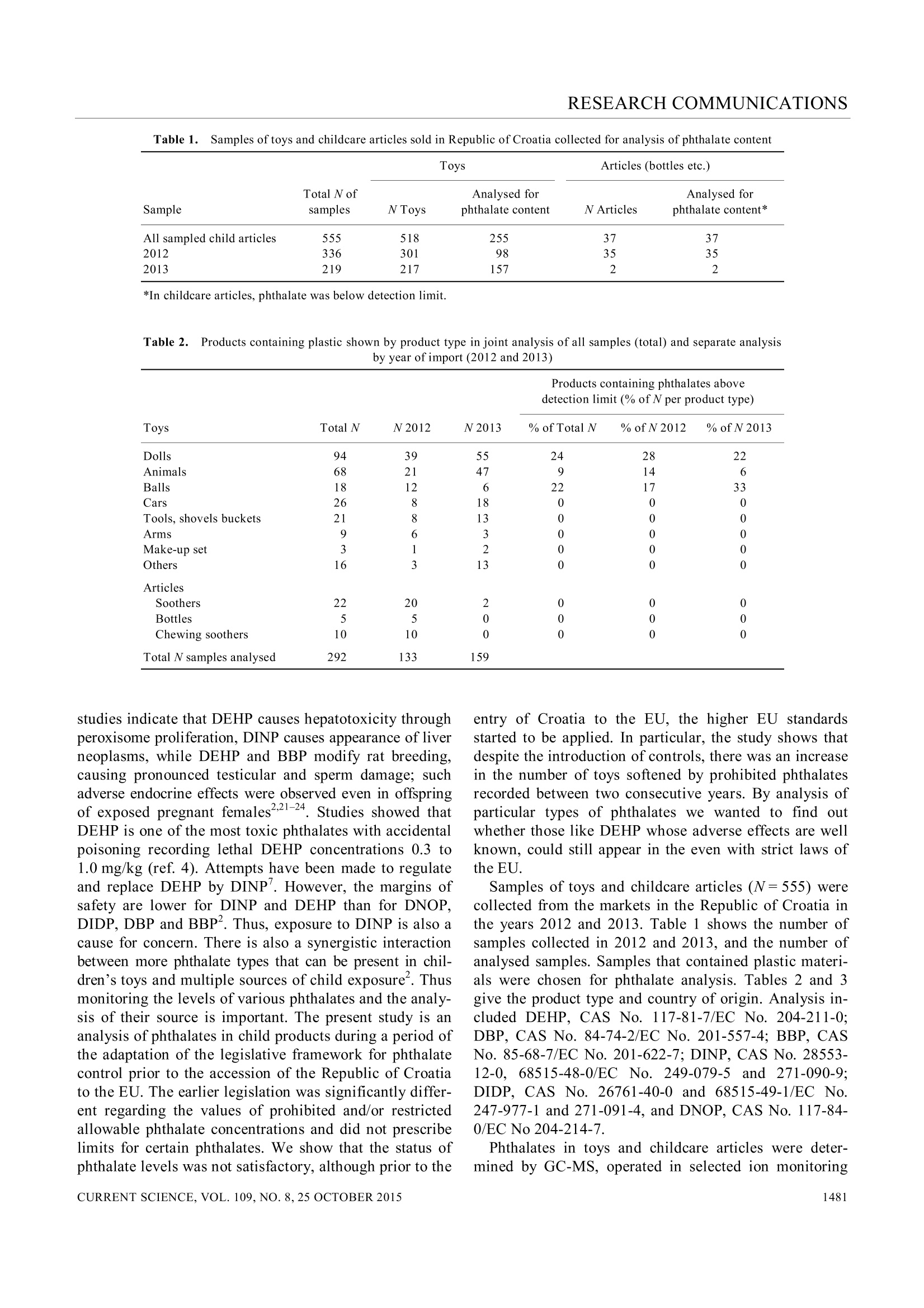





还剩5页未读,是否继续阅读?
产品配置单
中国格哈特为您提供《克罗地亚儿童玩具和儿童保育用品中的邻苯二甲酸酯》,该方案主要用于玩具中特定邻苯二甲酸酯增塑剂检测,参考标准--,《克罗地亚儿童玩具和儿童保育用品中的邻苯二甲酸酯》用到的仪器有格哈特全自动快速溶剂萃取仪Sox416、格哈特传统经典索氏提取/萃取仪EV6 AII16、格哈特快速干燥仪STL56、玻璃滤筒、滤纸筒、棕色避光防紫外线萃取杯、德国移液器MM
相关方案
更多

